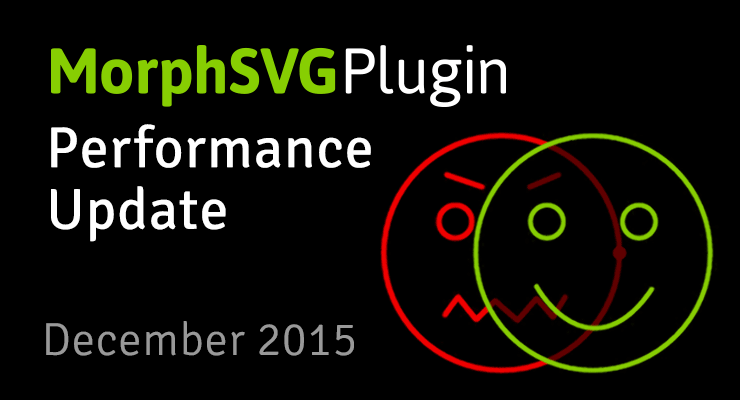Search the Community
Showing results for tags 'morphing'.
-
Hi everyone, long time fan and first time poster, I had the following question regarding svg morph, when my two shapes are morphing you can see a harsh outline of the svg viewbox is there a way to avoid this? I am also trying to trigger this animation on scroll using scrolltrigger - would anyone be kind of enough to advise me of best practices of using morph and scrolltrigger together in react? Attached is a codepen demo. Thank you for your help and amazing product.
-
Hello, I'm trying to have animate a clip path on a div. The div contains an image or a video. The clip path is in a svg, and i use css to apply the clip path, but the animation is laggy. I have tried to insert an image into to the svg the animations i smooth. When i try to use foreignObject to put the video into the svg. The animations is smooth, but there is somekind border on the foreignObject. Currently im stocked how to proceed, what should i search for, how do i debug? In my codepen the first two examples is clippath on a div with some element inside. The next two is the element inside the svg.
-
Hello, I am new to animation and SVG in general. I am using attr property to morph between 2 paths in a SVG. I created the shapes with same number of anchor points in Illustrator. The problem I am experiencing is that at the start of the animation, the path is all messed up. I am not sure if what I did is correct but how can I achieve that the starting path is the one given and start expanding from there towards the new path? I created a codesandbox showing this behavior at https://codesandbox.io/s/falling-dew-7l0cz?file=/src/Animate.js I was able to animate it correctly using different frames and a timeline, but is not as smooth. Any help is greatly appreciated.
-
Note: This page was created for GSAP version 2. We have since released GSAP 3 with many improvements. While it is backward compatible with most GSAP 2 features, some parts may need to be updated to work properly. Please see the GSAP 3 release notes for details. MorphSVG's default settings typically deliver beautiful results but sometimes you may need to tweak things to get a certain effect or avoid weird transitional states or kinks. This video explains advanced features of MorphSVGPlugin that give you plenty of flexibility. Watch the video For more information and plenty of interactive demos, check out the MorphSVG docs. Happy tweening!
-
Note: This page was created for GSAP version 2. We have since released GSAP 3 with many improvements. While it is backward compatible with most GSAP 2 features, some parts may need to be updated to work properly. Please see the GSAP 3 release notes for details. Since launching MorphSVGPlugin, we've made a bunch of improvements and exposed several new features. Here are the highlights... The challenge Before we dive into solutions, it helps to understand the tasks that MorphSVGPlugin must perform in order to work its magic: Convert the path data string into pure cubic Beziers Map all of the segments between the start and end shapes (match them up), typically based on size and position If there are more segments in one than the other, fabricate new segments and place them appropriately Subdivide any segments with mis-matching point quantities If a shapeIndex number isn't defined, locate the one that delivers the smoothest interpolation (shortest overall distance that points must travel). This involves looping through all the anchor points and comparing distances. Convert all the data back into a string Isolate the points that need to animate/change and organize a data structure to optimize processing during the tween. That may sound like a lot of work (and it is) but MorphSVGPlugin usually rips through it with blazing speed. However, if you've got a particularly complex path, you'll appreciate the recent improvements and the new advanced options: Performance tip #1: define a shapeIndex MorphSVGPlugin's default shapeIndex:"auto" does a bunch of calculations to reorganize the points so that they match up in a natural way but if you define a numeric shapeIndex (like shapeIndex:5) it skips those calculations. Each segment inside a path needs a shapeIndex, so multiple values are passed in an array like shapeIndex:[5,1,-8,2]. But how would you know what numbers to pass in? The findShapeIndex() tool helps for single-segment paths, what about multi-segment paths? It's a pretty complex thing to provide a GUI for. Typically the default "auto" mode works great but the goal here is to avoid the calculations, so there is a new "log" value that will act just like "auto" but it will also console.log() the shapeIndex value(s). That way, you can run the tween in the browser once and look in your console and see the numbers that "auto" mode would produce. Then it's simply a matter of copying and pasting that value into your tween where "log" was previously. For example: TweenMax.to("#id", 1, {morphSVG:{shape:"#otherID", shapeIndex:"log"}}); //logs a value like "shapeIndex:[3]" //now you can grab the value from the console and drop it in... TweenMax.to("#id", 1, {morphSVG:{shape:"#otherID", shapeIndex:[3]}}); Notes shapeIndex:"log" was added in MorphSVGPlugin version 0.8.1. A single segment value can be defined as a number or a single-element array, like shapeIndex:3 or shapeIndex:[3] (both produce identical results) Any segments that don't have a shapeIndex defined will always use "auto" by default. For example, if you morph a 5-segment path and use shapeIndex:2, it will use 2 for the first segment and "auto" for the other four. Performance tip #2: precompile The biggest performance improvement comes from precompiling which involves having MorphSVGPlugin run all of its initial calculations listed above and then spit out an array with the transformed strings, logging them to the console where you can copy and paste them back into your tween. That way, when the tween begins it can just grab all the values directly instead of doing expensive calculations. For example: TweenMax.to("#id", 1, {morphSVG:{shape:"#otherID", precompile:"log"}}); //logs a value like precompile:["M0,0 C100,200 120,500 300,145 34,245 560,46","M0,0 C200,300 100,400 230,400 100,456 400,300"] //now you can grab the value from the console and drop it in... TweenMax.to("#id", 1, {morphSVG:{shape:"#otherID", precompile:["M0,0 C100,200 120,500 300,145 34,245 560,46","M0,0 C200,300 100,400 230,400 100,456 400,300"]}}); As an example, here's a really cool codepen by Dave Rupert before it was precompiled: http://codepen.io/davatron5000/pen/meNOqK/. Notice the very first time you click the toggle button, it may seem to jerk a bit because the entire brain is one path with many segments, and it must get matched up with all the letters and figure out the shapeIndex for each (expensive). By contrast, here's a fork of that pen that has precompile enabled: http://codepen.io/GreenSock/pen/MKevzM. You may noticed that it starts more smoothly. Notes precompile was added in MorphSVGPlugin version 0.8.1. Precompiling only improves the performance of the first (most expensive) render. If your entire morph is janky throughout the tween, it most likely has nothing to do with GSAP; your SVG may be too complex for the browser to render fast enough. In other words, the bottleneck is probably the browser's graphics rendering routines. Unfortunately, there's nothing GSAP can do about that and you'll need to simplify your SVG artwork and/or reduce the size at which it is displayed. The precompiled values are inclusive of shapeIndex adjustments. In other words, shapeIndex gets baked in. In most cases, you probably don't need to precompile; it's intended to be an advanced technique for squeezing every ounce of performance out of a very complex morph. If you alter the original start or end shape/artwork, make sure you precomple again so that the values reflect your changes. Better segment matching In version 0.8.1, there were several improvements made to the algorithm that matches up corresponding segments in the start and end shapes so that things just look more natural. So even without changing any of your code, loading the latest version may instantly make things match up better. map: "size" | "position" | "complexity" If the sub-segments inside your path aren't matching up the way you hoped between the start and end shapes, you can use the map special property to tell MorphSVGPlugin which algorithm to prioritize: "size" (the default) - attempts to match segments based on their overall size. If multiple segments are close in size, it'll use positional data to match them. This mode typically gives the most intuitive morphs. "position" - matches mostly based on position. "complexity" - matches purely based on the quantity of anchor points. This is the fastest algorithm and it can be used to "trick" things to match up by manually adding anchors in your SVG authoring tool so that the pieces that you want matched up contain the same number of anchors (though that's completely optional). TweenMax.to("#id", 1, {morphSVG:{shape:"#otherID", map:"complexity"}}); Notes map is completely optional. Typically the default mode works great. If none of the map modes get the segments to match up the way you want, it's probabaly best to just split your path into multiple paths and morph each one. That way, you get total control. Animate along an SVG path The new MorphSVGPlugin.pathDataToBezier() method converts SVG <path> data into an array of cubic Bezier points that can be fed directly into a BezierPlugin-based tween so that you can essentially use it as a motion guide. Watch the video Demo See the Pen pathDataToBezier() docs official by GreenSock (@GreenSock) on CodePen. Morph back to the original shape anytime If you morph a path into various other shapes, and then you want to morph it back to its original shape, it required saving the original path data as a variable and feeding it back in later. Not anymore. MorphSVGPlugin records the original path data in a "data-original" attribute directly on the element itself, and then if you use that element as the "shape" target, it will automatically grab the data from there. For example: TweenMax.to("#circle", 1, {morphSVG:"#hippo"}); //morphs to hippo TweenMax.to("#circle", 1, {morphSVG:"#camel"}); //morphs to camel TweenMax.to("#circle", 1, {morphSVG:"#circle"}); //morphs back to circle. Conclusion We continue to be amazed by the response to MorphSVGPlugin and the creative ways we see people using it. Hopefully these new features make it even more useful. How do I get MorphSVGPlugin? If you're a "Shockingly Green" or "Business Green" Club GreenSock member, just download the zip from your account dashboard or the download overlay on GSAP-related page on this site. If you haven't signed up for Club GreenSock yet, treat yourself today.
- 3 comments
-
- svg
- precompile
-
(and 10 more)
Tagged with:
-
My web development agency is looking for a freelancer to develop a full page slider image with morphing transition. We have a special request from our customer and are not experimented with GreenSock/GSAP. We would like something very similar than https://delcambio.me landing page. We will only need the image morphing transition slider code, that we will implement in our current project (Laravel/HTML5). Project: Start date: mid-March Slider delivery deadline: mid-April Deliver a working HTML file with all assets Specify licences to purchase if any Image sample will be given. (black background dominante) Please send us: Libraries and versions required (GSAP? TweenLite?, jQuery? +++) Estimated delivery time Expected price for the task If you have a portfolio with similar work that would be perfect! Thanks. Adrien. adrien@acte-solutions.com
-
Hi! Trying to figure out morphing thing. I made a circle in Illustrator, turned it to the path, then I also made a blob from this circle (with the same 4 anchors). Now I am trying to morph `path` one in another and having this bugs: I am not sure why this happening? How to morph this 2 shapes (w\out using MorphSVG right now, I need to figure this out first).
-
Hi, I have a React component that is a replica of the Reddit character. It is composed of several grouped paths and I would like to conditionally render a different face on the character based on the value of this.state.face in the component and tween the animation when the faces change. In the codepen example, I have two alternative groups of paths: base_face and angry_face. I use a ternary operator to click and show each version, but I can't figure out how to tween a group of paths to animate from base_face to angry_face and vice versa. Any help would be greatly appreciated. Thanks, Paul
-
Carl brought up this canvas morphing demo I made... http://codepen.io/osublake/pen/RWeOWX But it's kind of old, so I told him I would make an updated version because doing canvas morphing is much easier now. You no longer have to use an actual SVG path as a proxy to get the transformed path strings. There's an undocumented method that the precompile option uses (pathFilter), so you a can tap into that to get the transformed path strings. // Path strings var path1 = "M300,25l86.6,150H213.4Z" var path2 = "M500,23.92L524.72,74,580,82l-40,39,9.44,55.05-49.44-26-49.44,26L460,121,420,82l55.28-8Z"; // Data for the start and end paths var pathData = [path1, path2]; // Run it through the MorphSVGPlugin MorphSVGPlugin.pathFilter(pathData); Using the pathFilter method might seem awkward at first because it doesn't return anything. It mutates the array you pass into it with the transformed path strings... http://codepen.io/osublake/pen/1754cdf8805e7061094036125958200d?editors=0011 There are also some other things you can pass in the pathFilter method, like a shapeIndex and map type... MorphSVGPlugin.pathFilter(pathData, 6, "complexity"); The next step is to decide on how you want to tween the pathData. In the past I would convert the pathData strings into a bunch of arrays of numbers, and tween the arrays using the EndArrayPlugin, kind of like in this demo I made before the MorphSVGPlugin came out... http://codepen.io/osublake/pen/RPKdQz?editors=0010 But that can get messy, and there's a much better solution with modern browsers, the Path2D object. It will allow you to use SVG paths directly inside of canvas. var path = new Path2D("M10 10 h 80 v 80 h -80 Z"); context.fill(path); And since GSAP can tween complex strings, we now have a pretty straightforward way to do morphing inside canvas! http://codepen.io/osublake/pen/EZNMEZ/?editors=0010 However, there is one issue. There won't be any IE support for this, and the SVG constructor feature is currently broken in Edge. Hopefully that will get resolved soon. https://developer.microsoft.com/en-us/microsoft-edge/platform/issues/8438884/ So there you go. High-performance morphing using GSAP and canvas. Morphing 50 different shapes while using a blend mode. http://codepen.io/osublake/pen/pRNYRM/?editors=0010 .
-
Hello guys, I recently started developing with GSAP and i love it so far, its really great but my problem is that i am not able to change the anchor point of the circle... even if we assign a top, left and bottom anchor point to it it just takes the default anchor point on the circle due to this issue the animation isn't the same on both sides and it looks really weird. does someone know how to fix this issue? i also saw a solution over here from OSUblake, but i am not able to figure out how to make that work http://greensock.com/forums/topic/14129-morphsvg-change-start-and-end-point/ kind regards
-
Hello, I'm trying to implement the morphing plugin on an accordion module to morph the "+" to a "-" when the answer is in an open state when clicked and back again on the second click or if another trigger is clicked. But when any of the trigger elements is clicked all of the svgs morph. I would appreciate any help you could offer. Thanks, Tim
-
OK.. so If we need to animate a very simple shape, a vesica pisces, into simple circle.. .. Can GSAP handle that, or must we use something like SnapSVG.js? Specifically, I need to animate this shape into a perfect circle. (a solid shape with a fill, no stroke.) (They both have the same number of points.) Maybe a shape morphing plugin is in the works? MorphSVG? Thanks !



.thumb.jpg.45ad1f0654d8c8cd759c47599fe1796d.jpg)

